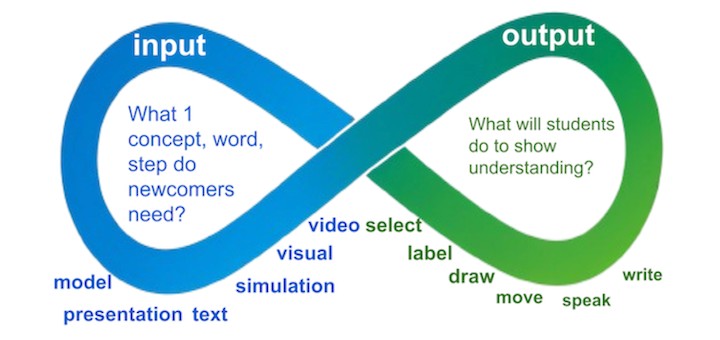The Input-Output Loop: It’s Chunking 2.0 for MLs
A MiddleWeb Blog

The Need
One of the main things that multilingual learners (MLs) tell me about their learning is that they just don’t understand the content. They often list reasons such as unfamiliar words and lots of information coming at them way too fast.
Yet as I’ve worked in teachers’ classrooms, I’ve observed classes where students comprehended the content despite experiencing unfamiliar content and regardless of the amount of details students had to learn.
I asked myself what were these highly effective teachers doing to make content comprehensible to a diverse room.
After seeing a diverse array of teaching styles in various content areas, I observed a common practice for making any content more accessible. This was the intention:
(1) deliver content in manageable chunks, and
(2) provide students with immediate opportunities to process the content and for teachers to gather formative data.
While some teachers will use the term chunking, I have found that it doesn’t capture specifically what MLs need. That’s because there’s no explicit mention of creating opportunities for students to process the content. When MLs are lost, the teacher often thinks they’ve already “chunked” the content by segmenting the content by topics. They might say, “Ok, now that I’ve explained the art element of space to you, let’s move to the next element of texture.”
This version of chunking is content delivery through “explanation” without providing opportunities to process the content. In essence, we might have “taught” the content, but I highly doubt students have “learned” anything without processing opportunities.
Some teachers argue that processing opportunities have been given in the form of note-taking during the lesson. The reality is that “taking notes” is often just copying from a presentation. I define processing opportunities as a prompt that requires students to use or recall the information. These opportunities happen directly in class as content is being shared, not at the end of the lesson and not assigned for homework
The Input-Output Loop
In my forthcoming book with Beth Skelton called Structured Success for Experienced Multilinguals, we are proposing a protocol called the Input-Output Loop as “chunking 2.0” – designed specifically for MLs. The protocol builds on the two core tenants of chunking (see above), but we are explicitly calling out these two principles in the name of our protocol to remind teachers to integrate opportunities to process the content.
Additionally, the Input-Output Loop is designed specifically for MLs because teachers can use it to teach the dimensions of language, which consists of word, sentence, and organization. Teachers can use the loop to design content to be comprehensible at the word, sentence, or organization level. When MLs are asked to process the content, they will do so at the word, sentence, or organization level.
Establishing input
As teachers design their lessons, I encourage them to segment their lessons by key details, ideas, steps, or concepts. For example, the art teacher might identify the six elements of art (e.g., shape, color, space, texture, lines, and form). Each of these is to be taught as discrete knowledge in the lesson at the word level. Teaching each one separately provides opportunities for each one to be learned authentically.
Teaching one by one means the educator values students learning the content and not the content simply being covered. Additionally, teaching content in manageable units means that MLs will more likely be able to apply the content independently because they have grasped each concept.
Opportunity for output
Before moving on to the next detail, idea, concept, or step, the loop reminds us to have MLs process each chunk of the content. Process always means MLs have to communicate their understanding by pointing, drawing, manipulating objects, saying something, or writing something. Students might write a word, speak in a sentence, or make an outline of their ideas to show organization. In this way, MLs are developing their dimensions of language about content knowledge.
An additional purpose of having MLs process the content is for teachers to gather formative data. The data lets teachers know if they should move on to the next content or provide clarifying instruction. This is particularly beneficial for MLs, as their teachers will have determined if the concept was understood. Without this formative data, teachers might move on prematurely. Since knowledge builds on each element, MLs cannot comprehend the next concept because the previous requisite concept was lost to them.

After that, she had students return to the shape they previously identified and explain in a complete sentence what effect the shape had on the sculpture. This is processing at the sentence level, and by creating sentences, students were learning to use art-based language to grasp an art concept. Based on students’ responses, she could determine if it was appropriate for her to move on to the next art element and to provide clarifying instruction.
This exchange was quick, allowed for the content to be taught, and had MLs process the content. From the viewer’s perspective, it looked like hands-on, student-centered instruction. In reality, it was instruction that was carefully segmented for accessibility and offered opportunities for students to process the content.
Conclusion
I wholeheartedly believe that MLs are capable of learning any content. It’s not the complexity of the content that is the hindrance to their achievement. It’s the quality of instruction that determines their achievement. With the Input-Output Loop, the quality of our instruction improves. MLs benefit from this as content becomes accessible. Knowledge is segmented in manageable units and internalized by students as they engage in processing activities.





























